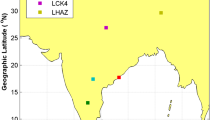Abstract
This paper presents the performance of the latest version of the International Reference Ionosphere (IRI-2016) model for estimating the Total Electron Content (TEC) variations in the mid-latitudinal Turkish regions during low solar activity years (2015–2018). Moreover, TEC is estimated from dual-frequency Global Navigation Satellite System (GNSS) receivers operating in different regions of Turkey: Zonguldak (41.44 °N, 31.77 °E), Ankara (39.88 °N, 32.75 °E) and Antalya (36.88 °N, 30.66 °E). The diurnal, monthly and seasonal variations in the measured TEC are compared with the prediction of modelled TEC. The results reveal minimum variations in the diurnal TEC after midnight hours 21:00–24:00 Universal Time (\(\text{UT}=\text{LT}+3{:}00~\text{hrs}\)) and maximum TEC enhancement during the daytime from 9:00–15:00 UT (12:00–18:00 LT). The monthly mean TEC from measured and modelled estimation depicts the highest and lowest values in April and December during the years 2015–2018, respectively. Moreover, the low and high seasonal variations are observed in equinoxes and winter solstice, respectively. Furthermore, it is observed that IRI-2016 model underestimates the measured values, especially during the daytime (12:00–18:00 LT) at each station. The correlation coefficient between the measured and modelled TEC is found in the range (\(R=0.81\text{--}0.85\)) during the years 2015–2018, which exhibits a high positive correlation over the regions. The model predicted TEC is showing a good agreement with measured TEC of the ionospheric dynamics over the regions, which manifests the radio signals accuracy over the mid-latitude regions, particularly Turkey.












Similar content being viewed by others
References
Ansari, K., Corumluoglu, O., Panda, S.K.: Analysis of ionospheric TEC from GNSS observables over the Turkish region and predictability of IRI and SPIM models. Astrophys. Space Sci. 362, 65 (2017a)
Ansari, K., Panda, S.K., Althuwaynee, O.F., Corumluoglu, O.: Ionospheric TEC from the Turkish Permanent GNSS Network (TPGN) and comparison with ARMA and IRI models. Astrophys. Space Sci. 362, 178 (2017b)
Ansari, K., Panda, S.K., Corumluoglu, O.: Mathematical modelling of ionosperic TEC from Turkis permanent GNSS Network (TPGN) observables during 2009–2017 and predictability of NeQuick and Kriging models. Astrophys. Space Sci. 363, 42 (2018)
Arikan, F., Arikan, O., Erol, C.B.: Regularized estimation of TEC from GPS data for certain midlatitude stations and comparison with the IRI model. Adv. Space Res. 39, 867–874 (2007)
Atıcı, R.: Comparison of GPS TEC with modelled values from IRI 2016 and IRI-PLAS over Istanbul, Turkey. Astrophys. Space Sci. 363, 231 (2018)
Bagiya, M.S., Joshi, H., Iyer, K., Aggarwal, M., Ravindran, S., Pathan, B.: TEC variations during low solar activity period (2005–2007) near the Equatorial Ionospheric Anomaly Crest region in India. Ann. Geophys. 27, 1047–1057 (2009)
Barkat, A., Ali, A., Rehman, K., Awais, M., Tariq, M.A., Ahmed, J., Amin, M.A., Iqbal, T.: Multi-precursory analysis of Phalla earthquake (July 2015; Mw 5.1) near Islamabad, Pakistan. Pure Appl. Geophys. 175, 1–16 (2018)
Bilitza, D.: International reference ionosphere 2000. Radio Sci. 36, 261–275 (2001)
Bilitza, D., Hernandez-Pajares, M., Juan, J., Sanz, J.: Comparison between IRI and GPS-IGS derived electron content during 1991–1997. Phys. Chem. Earth, Part C, Sol.-Terr. Planet. Sci. 24, 311–319 (1999)
Chartier, A.T., Mitchell, C.N., Jackson, D.R.: A 12 year comparison of MIDAS and IRI 2007 ionospheric Total Electron Content. Adv. Space Res. 49, 1348–1355 (2012)
Ciraolo, L., Azpilicueta, F., Brunini, C., Meza, A., Radicella, S.: Calibration errors on experimental slant total electron content (TEC) determined with GPS. J. Geod. 81, 111–120 (2007)
Coïsson, P., Radicella, S.M.: Ionospheric topside models compared with experimental electron density profiles. Ann. Geophys. 48 (2005)
Coisson, P., Radicella, S., Ciraolo, L., Leitinger, R., Nava, B.: Global validation of IRI TEC for high and medium solar activity conditions. Adv. Space Res. 42, 770–775 (2008)
Ezquer, R.G., Scidá, L.A., Orué, Y.M., Nava, B., Cabrera, M.A., Brunini, C.: NeQuick 2 and IRI Plas VTEC predictions for low latitude and South American sector. Adv. Space Res. 61, 1803–1818 (2018)
Gordiyenko, G., Yakovets, A.: Comparison of midlatitude ionospheric F region peak parameters and topside Ne profiles from IRI2012 model prediction with ground-based ionosonde and Alouette II observations. Adv. Space Res. 60, 461–474 (2017)
Guo, J., Li, W., Liu, X., Kong, Q., Zhao, C., Guo, B.: Temporal-spatial variation of global GPS-derived total electron content, 1999–2013. PLoS ONE 10, e0133378 (2015)
Hofmann-Wellenhof, B., Lichtenegger, H., Collins, J.: Global Positioning Systems Theory and Practice. Springer, New York (1992)
Inyurt, S., Sekertekin, A.: Modeling and predicting seasonal ionospheric variations in Turkey using artificial neural network (ANN). Astrophys. Space Sci. 364, 62 (2019)
Inyurt, S., Yildirim, O., Mekik, C.: Comparison between IRI-2012 and GPS-TEC observations over the western Black Sea. Ann. Geophys. 35, 817 (2017)
Jin, S., Jin, R., Li, J.: Pattern and evolution of seismo-ionospheric disturbances following the 2011 Tohoku earthquakes from GPS observations. J. Geophys. Res. Space Phys. 119, 7914–7927 (2014)
Klobuchar, J.A.: Ionospheric time-delay algorithm for single-frequency GPS users. Air Force Systems Command Hanscom AFB MA Geophysics Lab. (1987)
Klobuchar, J.A.: Ionospheric effects on GPS. In: Global Positioning System: Theory and Application. American Institute of Aeronautics and Astronautics, Washington D.C. (1996)
Li, Z., Yuan, Y., Wang, N., Hernandez-Pajares, M., Huo, X.: SHPTS: towards a new method for generating precise global ionospheric TEC map based on spherical harmonic and generalized trigonometric series functions. J. Geod. 89, 331–345 (2015)
Liu, L., Wan, W., Zhang, M.-L., Zhao, B.: Case study on total electron content enhancements at low latitudes during low geomagnetic activities before the storms. Ann. Geophys. 26, 893–903 (2008a)
Liu, L., Wan, W., Zhang, M.L., Zhao, B., Ning, B.: Prestorm enhancements in \(\text{Nm}F_{2}\) and total electron content at low latitudes. J. Geophys. Res. Space Phys. 113, A02311 (2008b)
Liu, L., Ding, Z., Zhang, R., Chen, Y., Le, H., Zhang, H., Li, G., Wu, J., Wan, W.: A case study of the enhancements in ionospheric electron density and its longitudinal gradient at Chinese low latitudes. J. Geophys. Res. Space Phys. 125, e2019JA027751 (2020)
Luo, W., Liu, Z., Li, M.: A preliminary evaluation of the performance of multiple ionospheric models in low-and mid-latitude regions of China in 2010–2011. GPS Solut. 18, 297–308 (2014)
Mannucci, A.J., Wilson, B.D., Edwards, C.D.: A new method for monitoring the Earth’s ionospheric total electron content using the GPS global network (1993)
Misra, P., Enge, P.: Global Positioning System: Signals, Measurements and Performance, 2nd edn. p. 206. Ganga-Jamuna Press, Lincoln (2006)
Nigussie, M., Radicella, S., Damtie, B., Nava, B., Yizengaw, E., Groves, K.: Validation of the NeQuick 2 and IRI-2007 models in East-African equatorial region. J. Atmos. Sol.-Terr. Phys. 102, 26–33 (2013)
Otsuka, Y., Ogawa, T., Saito, A., Tsugawa, T., Fukao, S., Miyazaki, S.: A new technique for mapping of total electron content using GPS network in Japan. Earth Planets Space 54, 63–70 (2002)
Prasad, S., Rao, P.R., Prasad, D., Venkatesh, K., Niranjan, K.: On the variabilities of the Total Electron Content (TEC) over the Indian low latitude sector. Adv. Space Res. 49, 898–913 (2012)
Rios, V., Medina, C., Alvarez, P.: Comparison between IRI predictions and digisonde measurements at Tucuman. J. Atmos. Sol.-Terr. Phys. 69, 569–577 (2007)
Sardon, E., Rius, A., Zarraoa, N.: Estimation of the transmitter and receiver differential biases and the ionospheric total electron content from Global Positioning System observations. Radio Sci. 29, 577–586 (1994)
Şentürk, E., Çepni, M.S.: Ionospheric temporal variations over the region of Turkey: a study based on long-time TEC observations. Acta Geod. Geophys. 53, 623–637 (2018)
Shah, M., Jin, S.: Statistical characteristics of seismo-ionospheric GPS TEC disturbances prior to global \(\text{Mw}\geq 5.0\) earthquakes (1998–2014). J. Geodyn. 92, 42–49 (2015)
Tariku, Y.A.: Mid latitude ionospheric TEC modeling and the IRI model validation during the recent high solar activity (2013–2015). Adv. Space Res. 63, 4025–4038 (2019)
Tariq, M.A., Shah, M., Hernández-Pajares, M., Iqbal, T.: Ionospheric VTEC variations over Pakistan in the descending phase of solar activity during 2016–17. Astrophys. Space Sci. 364, 99 (2019a)
Tariq, M.A., Shah, M., Hernández-Pajares, M., Iqbal, T.: Pre-earthquake ionospheric anomalies before three major earthquakes by GPS-TEC and GIM-TEC data during 2015–2017. Adv. Space Res. 63, 2088–2099 (2019b)
Tariq, M.A., Shah, M., Ulukavak, M., Iqbal, T.: Comparison of TEC from GPS and IRI-2016 model over different regions of Pakistan during 2015–2017. Adv. Space Res. 64, 707–718 (2019c)
Thu, H.P.T., Amory-Mazaudier, C., Le Huy, M.: Time variations of the ionosphere at the northern tropical crest of ionization at Phu Thuy, Vietnam (2011)
Venkatesh, K., Rama Rao, P., Saranya, P., Prasad, D., Niranjan, K.: Vertical electron density and topside effective scale height (HT) variations over the Indian equatorial and low latitude stations. Ann. Geophys. 29, 1861–1872 (2011)
Wu, C.-C., Fry, C., Liu, J.-Y., Liou, K., Tseng, C.-L.: Annual TEC variation in the equatorial anomaly region during the solar minimum: September 1996–August 1997. J. Atmos. Sol.-Terr. Phys. 66, 199–207 (2004)
Yuan, Y-b., Tscherning, C.C., Knudsen, P., Xu, G., Ou, J-k.: The ionospheric eclipse factor method (IEFM) and its application to determining the ionospheric delay for GPS. J. Geod. 82, 1–8 (2008)
Zakharenkova, I., Cherniak, I.V., Krankowski, A., Shagimuratov, I.: Vertical TEC representation by IRI 2012 and IRI Plas models for European midlatitudes. Adv. Space Res. 55, 2070–2076 (2015)
Acknowledgements
The authors are very grateful to the OMNI web, NASA, and Kyoto University for providing TEC data from the latest version of the IRI-2016 model and geomagnetic storm indices, respectively. The authors are also grateful to TUSAGA-Aktif for providing RINEX data files. We are also thankful to the Editor and anonymous reviewer for providing useful comments. This research was supported by the B-type Strategic Priority Program of the Chinese Academy of Sciences (XDB41000000), National Natural Science Foundation of China (42030202, 41774161), and “National key research and development program” (2017YFE0131400).
Author information
Authors and Affiliations
Corresponding author
Additional information
Publisher’s Note
Springer Nature remains neutral with regard to jurisdictional claims in published maps and institutional affiliations.
Rights and permissions
About this article
Cite this article
Tariq, M.A., Shah, M., Inyurt, S. et al. Comparison of TEC from IRI-2016 and GPS during the low solar activity over Turkey. Astrophys Space Sci 365, 179 (2020). https://doi.org/10.1007/s10509-020-03894-3
Received:
Accepted:
Published:
DOI: https://doi.org/10.1007/s10509-020-03894-3




